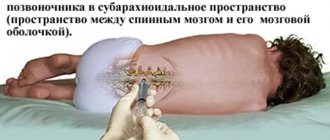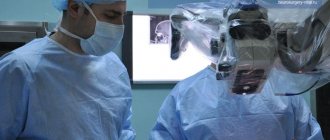Classification
By form: basilar meningitis, meningoencephalitis, cerebrospinal meningitis.
According to the nature of the course of tuberculous meningitis: acute, subacute, chronic, recurrent.
PATHOGENESIS AND PATHOMORPHOLOGY
The most characteristic morphological manifestations of tuberculous lesions of the soft membranes of the brain are the rash of miliary tubercles and the appearance of serous-fibrinous exudate in the subarachnoid space. The membranes of the brain lose their transparency and become cloudy, covered with a jelly-like effusion. This process is most intensely expressed at the base of the brain. Tuberculosis tubercles can also be located on the outer surface of the brain, in the area of the lateral (Sylvian) fissure, along the cerebral vessels, but here their number is significantly less than at the base of the brain. The tubercles, the size of a millet grain or slightly smaller, initially have a grayish color and are hardly noticeable, but then, as a result of caseous decay, they acquire a yellowish color and become clearly visible. Inflammatory changes in the acute stage of tuberculous meningitis are of a pronounced exudative nature. Microscopically, diffuse infiltration of the soft meninges with lymphocytes and macrophages is detected; polynuclear cells are less common. The tubercles have a characteristic epithelioid structure and contain giant cells. In the center of several tubercles there is caseous decay. Infiltrates of lymphocytes and plasma cells form around the venous vessels. As a rule, with tuberculous meningitis, not only the membranes, but also the substance of the brain are affected. The ventricles of the brain are distended and contain cloudy fluid.
Will an MRI show meningitis?
Magnetic resonance imaging is used in the complex diagnosis of infectious and inflammatory diseases of the brain. The procedure allows you to obtain layer-by-layer images of the organ in three planes. In the images, the doctor can identify signs characteristic of the inflammatory process in the membranes and nerve tissue.
Information about the characteristics of pathological changes helps to determine the stage of the disease, select the correct therapeutic tactics, and prevent complications. Repeated MRI scans of the brain make it possible to evaluate the effectiveness of treatment and identify foci of purulent changes. Angiography and contrast are informative regarding vascular thrombosis, cerebral edema, early diagnosis of heart attacks and strokes. To the question “will an MRI show meningitis?” radiologists give an affirmative answer. Each stage of disease development has characteristic MRI signs. But the diagnosis is made based on the results of a lumbar puncture and cerebrospinal fluid analysis.
Rheumatoid meningitis with stroke-like abnormalities on MRI: DWI (a), ADC map (b), FLAIR (c), T1 WI with contrast (d)
Epidemiology
Among extrapulmonary forms, tuberculous meningitis accounts for only 2-3%. In recent years, 18-20 cases of tuberculosis of the central nervous system and meninges have been registered in the Russian Federation (Tuberculosis in the Russian Federation, 2011). The prevalence of TBM is a generally recognized marker of tuberculosis distress in a territory. In various regions of the Russian Federation, the prevalence of TBM is from 0.07 to 0.15 per 100,000 population. In the context of the HIV epidemic, the incidence of TBM tends to increase.
VISUALIZATION: CT, MRI
Tomographic types of meningoencephalitis
Magnetic resonance scanning reveals different stages of the disease. Early onset (during the first three days) is accompanied by the formation of infiltrate and edema. Cerebritis in the first week leads to necrotic changes in the cerebral parenchyma. MRI images show areas of destruction and impaired peripheral blood supply. The formation of the limiting capsule begins on days 12-14. The addition of purulent flora leads to the development of a destructive cavity (abscess).
Putrefactive decomposition of the brain structure causes death. High mortality in cerebritis is characterized by the presence of a three-layer capsule. The central part of the formation on a magnetic resonance imaging scan is characterized by increased signal. The peripheral presence of cystic cavities and secondary abscesses indicates severe damage to the parenchyma.
MRI images help distinguish areas of destruction from metastases. The latter forms do not have a capsule. Diffusion-weighted images show the peripheral capsule, the internal contents of the cavity.
MRI picture of cerebral abscess:
- Purulent central focus;
- Weak signal from the peripheral capsule;
- Peripheral swelling.
After contrasting, the wall is clearly visible.
The transition of inflammation to the wall of the fourth ventricle is ependymitis (ventriculitis). The nosology develops when the infection moves from the meninges to the basal cisterns. Infection is likely to enter through pathological shunts. The enhancing substance spreads through the capillary system.
Clinical manifestations
The onset of the disease is subacute; there is often a prodromal period with increased fatigue, weakness, headache, anorexia, sweating, sleep inversion, and character changes, especially in children. Body temperature is subfebrile. Vomiting often occurs as a result of headaches. The prodromal period lasts 2-3 weeks. Then, mild meningeal symptoms gradually appear (stiff neck, Kernig's sign, etc.) Signs of damage to the III and VI pairs of the cranial nerves appear early. In the later stages, if the disease is not recognized and specific treatment is not started, paresis of the limbs, aphasia and other symptoms of focal brain damage may occur. The most typical course of the disease is subacute. In this case, the transition from prodromal phenomena to the period of appearance of membrane symptoms occurs gradually, on average within 4-6 weeks. Acute onset is less common (usually in young children and adolescents). A chronic course is possible in patients who were previously treated with specific drugs for tuberculosis of internal organs.
Tub. meningitis: basic information
Tuberculous meningitis has been considered a separate form of the disease since 1893, when microbiologists first discovered Mycobacterium tuberculosis in the cerebrospinal fluid of a patient.
Until recently, meningitis was considered a disease of childhood, or less often of adolescence. But today, meningitis is increasingly common among adults. The most susceptible to the tuberculous form of meningitis are people with reduced immunity due to HIV, alcoholism, drug addiction, old age, and malnutrition.
In 90% of cases, tuberculous meningitis is a secondary form of tuberculosis. process, that is, it develops against the background of previous tuberculosis, or with active tuberculosis. process in other organs. The tuberculosis focus in 80% of all cases is localized in the lungs.
Expert opinion
Author:
Andrey Igorevich Volkov
Neurologist, Candidate of Medical Sciences
Tuberculous meningitis is a severe form of tuberculosis. This disease often leads to death or disability. According to international recommendations, treatment for tuberculosis should be carried out for six months. However, there is a practice of therapy for nine, twelve or more months to prevent relapses.
It is necessary to identify the disease as quickly as possible. If the diagnosis is not established after 15 days, further treatment will be difficult and the likelihood of complications increases. Epilepsy, mental disorders, decreased hearing and vision, hydrocephalus, and disorders in the endocrine system may occur. Death is also likely. Doctors at the Yusupov Hospital detect tuberculous meningitis at an early stage. Treatment is carried out comprehensively in a hospital setting. For cure, special anti-tuberculosis therapy is prescribed taking into account the symptoms of meningitis and the fight against cerebral edema. The neurologist assesses the patient's condition and prescribes adequate decongestant treatment. If the patient has drug resistance, the doctor should prescribe the tablets keeping this aspect in mind.
Radiation diagnostics
CT semiotics: Changes may not be detected on images without contrast enhancement. In later stages, complications such as hydrocephalus and cerebral infarction due to ischemia can be detected. With intravenous contrast enhancement, intense accumulation of the contrast agent in the meninges is observed, mainly on the basal surface of the brain.
MRI semiotics
T1-weighted images: in the initial stages, changes are not detected; shortening of T1 (in the form of an increase in the MR signal) from the meninges can be observed as the disease progresses
T2-weighted image: exudate is usually isointense to cerebrospinal fluid (hyperintense MR signal)
FLAIR: hyperintense MR signal in the basal cisterns and sulci. Post-contrast FLAIR images may have greater specificity than post-contrast T1-weighted images in detecting leptomeningeal enhancement
Contrast-enhanced T1-weighted imaging reveals intense accumulation of contrast material in the meninges, predominantly on the basal surface of the brain. Pointed/linear areas of accumulation in the basal ganglia are characteristic of vasculitis. In rare cases, accumulation of the contrast agent in the ventricular ependyma may occur, which is characteristic of a complication of TBM - ventriculitis.
DIFFERENTIAL DIAGNOSIS is carried out with infectious meningitis of another etiology, neurosarcoidosis, meningeal carcinomatosis.
Fig. 1 CT scan of the brain in the axial plane after contrast enhancement demonstrates the typical accumulation of contrast in the basal cisterns for TBM [3]
Fig. 2 MRI of the brain, axial plane, FLAIR mode: in the basal parts of the brain (sella turcica, interpeduncular, bypass cistern, pineal region) areas of altered MR signal of increased intensity are visualized
Fig. 3 MRI of the brain in the axial plane, a – T1-VI (native), b – T1-WI (post-contrast): in the area of the cisterns of the base of the brain, uneven thickening of the meninges is detected, isointense on T1-WI (a), with intense accumulation of contrast agent (b)
The increase in morbidity and mortality from tuberculosis in the world and in Russia is due to the rapid spread of HIV infection [1-3, 10]. Since 2001, the highest rates of growth in the incidence of HIV infection in the world have been recorded in the Russian Federation. In total, in 2010, 509,734 people were registered in the country in whose blood antibodies to HIV were detected by immunoblotting. The total number of patients with tuberculosis in combination with HIV infection reached 24,963 people in 2010 - this is 5% of the number of patients with HIV infection. An important feature of the increase in incidence is the increase in the proportion of people with late stages of HIV infection: from 3.5% in 2005 to 11.4% in 2010, while 24,963 (5%) of them had active tuberculosis [7 , 10].
Until 2005, tuberculous meningitis (TM) was a fairly rare disease and was characterized by predominant damage to the membranes of the base of the brain [4, 6]. Due to the increase in the proportion of late stages of HIV infection from 2006 to the present, there has been a significant increase in the number of patients with TM, which necessitated the introduction of a new indicator into statistical reports [5, 9], reflecting the incidence of TM. Thus, in 2010 it was 0.13 per 100,000 population [5, 8].
The purpose of this work is to study the clinical features, diagnosis and pathomorphology of tuberculous meningoencephalitis (TME) in the late stages of HIV infection.
Material and methods
For the period 2007-2010. The results of observation of 140 patients were analyzed. The main group consisted of 120 patients with TME in the late stages of HIV infection (stage IVB). The comparison group included 20 patients with TM without HIV infection.
The average age of the patients was 30.5±8.5 years, 84.5% were men, 15.5% were women.
In 93.3% of patients in the main group, another localization of tuberculosis was simultaneously detected - damage to the lungs, all groups of lymph nodes, liver, spleen, kidneys, and less often other organs. 6.7% of patients had total damage to organs and systems. Respiratory tuberculosis was found in almost all patients.
TM without HIV infection proceeded mainly as an isolated lesion of the central nervous system; only 6 (30%) patients were diagnosed with disseminated pulmonary tuberculosis.
We studied X-ray data, the results of examining sputum and cerebrospinal fluid (CSF) for the presence of Mycobacterium tuberculosis using bacterioscopy, culture and PCR methods, immune status (CD4, CD8, CD4/CD8, viral load), determination of the content of protein, glucose, chlorides, cellular composition. CT and MRI of the brain were also performed.
In case of death, a pathomorphological examination was carried out in full in accordance with the established protocol. During autopsy, fragments of internal organs were fixed in 10% neutral formalin, processed according to standard methods, histological sections 3-5 microns thick were stained with hematoxylin and eosin, according to Van Gieson, Ziehl-Nielsen. Cytological preparations were studied with Romanovsky-Giemsa, Ziehl-Neelsen, and Gram stains. Immunohistochemistry (IHC) was performed using monoclonal antibodies to Myc. tuberculosis mouse
, clone 1.1/3/1, Vector.
Results and discussion
In 80 (66.7%) patients of the main group, the course of TME in the late stages of HIV infection was characterized by an acute onset without a clear prodromal period, hectic fever with the development of acute impairment of consciousness within 2-3 days from the onset of the disease, followed by the development of meningeal syndrome and symptoms of damage to the cranial nerves. In 40 (33.3%) patients, the onset of TME was asymptomatic or manifested by minimal symptoms and persistent changes in behavior - apathy, inadequate reaction to the environment, disorientation in place and time, partly in one’s own personality, impaired self-care skills, sometimes manifestations of aggression, a pronounced decrease in cognitive functions. In 20.2% of cases, a moderately severe cephalgic syndrome of a diffuse or local nature was observed.
TM without HIV infection was characterized by the presence of a clear prodromal period with the gradual development of intoxication syndrome, an increase in body temperature to febrile levels (90.2% of cases), increasing headache, up to unbearable (80.0%), often accompanied by nausea and no relief. relief by vomiting. Meningeal syndrome at the onset of the disease in patients of the main group was more often absent or mildly expressed, in contrast to TM without HIV infection (25.1 and 93.0%, respectively).
Damage to the cranial nerves in patients of the main group was observed 2.5 times less frequently than in the comparison group, which was obviously due to the convexital localization of damage to the meninges and substance of the brain. This is probably associated with more frequent cerebral and pyramidal symptoms and less pronounced meningeal syndrome.
Patients in the main group had severe immunosuppression: the number of CD4 lymphocytes was 100 cells/μl or less, the CD4/CD8 ratio was from 0.01 to 0.5, the viral load was from 500,000 cop/ml and above. The more acute the course of the disease, the lower the content of CD4 lymphocytes; CD4/CD8 ratio and higher - viral load. In fatal cases, the level of CD4 lymphocytes was 0-50 cells/μl, the CD4/CD8 ratio was 0.02-0.1.
In patients of the main group, the CSF, as a rule, revealed a moderate increase in protein (1-2 g/l), slight pleocytosis (on average 92±36 cells per μl) with a predominance of neutrophils (70-80%). In patients in the comparison group, the protein level in the CSF was significantly higher (from 3 to 10 g/l), pleocytosis reached 400-600 cells, mainly due to lymphocytes. Glucose levels in the main group decreased less significantly (1.3-1.9 mmol/l) than in the comparison group (0.7-0.9 mmol/l). The chloride content in the CSF did not differ significantly between the two groups. In patients of the main group, Mycobacterium tuberculosis was quite often detected in the CSF - by microscopy in 18 (15.0%) cases, culture - in 37 (30.8%), PCR - in 46 (38.3%), which is the most important criterion for diagnosing TM. It is extremely important to detect drug resistance of Mycobacterium tuberculosis in the CSF in 17 (45.9%) bacterial isolates, of which 9 (24.3%) had multiple drug resistance of Mycobacterium tuberculosis to drugs and 3 (8.1%) had extensive drug resistance. .
CT and MRI were used as an auxiliary diagnostic criterion for damage to the brain and membranes in 21 (17.5%) patients: foci of demyelination were identified in 13 (61.9%) patients, cerebrospinal fluid cysts - in 10 (47.6%), displacement of the median structures - in 5 (23.8%), decreased density of the brain substance - in 17 (81%), thickening of the meninges - in 2 (9.5%), impaired cerebrospinal fluid dynamics - in 18 (85.7%).
The study of the characteristics of the course of TME in patients of the main group made it possible to identify differences from the comparison group (see table)
.
Pathologically, TM without HIV infection was characterized by damage predominantly to the basal parts of the brain. The pia mater was jelly-like, swollen, with millet-like grayish miliary tubercles. TME revealed foci of caseous necrosis in the brain substance (Fig. 1)
.
Figure 1. Tuberculous meningoencephalitis in the absence of HIV infection. Caseous-necrotic focus in the substance of the brain, tubercular rashes of the pia mater. Unfixed macropreparation. Microscopically, in TM, in patients with a relatively intact immune status, the pia mater was edematous, with moderate fibrosis, vascular congestion, lymphoid infiltration of varying severity, miliary tubercles consisting of epithelioid cells, Pirogov-Langhans giant cells, with a lymphoid shaft along the periphery. Leukocytes could be detected in the inflammatory infiltrate. Tuberculous granulomas sometimes merged with foci of central caseous necrosis (Fig. 2)
. Figure 2. Tuberculous meningitis (without HIV infection). Fibrosis, pronounced lymphoid infiltration of the meninges, separately located and merging epithelioid giant cell granulomas with necrosis in the center. Hematoxylin and eosin staining. Uv. 200.
In case of TM in the late stages of HIV infection, a total lesion of the pia mater was determined, with the involvement of the convexital surfaces of the brain in the process of sheathing. Due to purulent impregnation, the membranes acquired a yellowish-greenish color (like a “purulent cap”), tuberculate rashes were not visualized (Fig. 3, 4)
.
Figure 3. Tuberculous meningitis due to HIV infection.
a - purulent impregnation of the membrane of the basal parts of the brain; b — damage to the membrane of the convexital surface of the brain. Unfixed macropreparations. Figure 4. Tuberculous meningitis due to HIV infection. a - in the pia mater there is pronounced edema, plethora, extensive purulent-necrotic foci without signs of granulomatous inflammation, pronounced vasculitis. Hematoxylin and eosin staining. Uv. 200; b — fragment with no signs of delineation of foci of tuberculous inflammation. Van Gieson staining. Uv. 200. With the development of TME, foci of destruction such as abscesses were identified in the brain substance. These changes give the impression of nonspecific bacterial inflammation, and only histological examination with additional stains and bacteriological examination can establish the tuberculous etiology of the process. In HIV-associated TME, the pia mater was edematous, sharply congested, with diffuse leukocyte, less often lymphoid-leukocyte infiltration. Purulent-necrotic lesions of a monomorphic structure with no signs of productive inflammation were located perivascularly (epithelioid and giant multinucleated cells were not detected in the vast majority of cases) (Fig. 5, 6)
.
Figure 5. HIV-associated tuberculous meningitis.
Abundance of acid-fast bacteria in the imprint smear of the pia mater. Ziehl-Neelsen staining. Uv. 1000. Figure 6. Mycobacteria in a purulent-necrotic focus of the pia mater. Immunohistochemical study with Myc. Tuberculosis mouse monoclonal antibody, clone 1.1/3/1, Vector. Uv. 1000. Purulent-necrotic foci similar to acute abscesses were also found in the brain matter. Characteristic was the development of vasculitis, including severe destructive forms, thrombovasculitis, which further intensified necrotic processes. In cytological preparations of impression smears of the pia mater and areas of brain destruction, as well as histobacterioscopically with Ziehl-Neelsen staining, a large number of acid-fast bacteria were found in necrotic masses and the cytoplasm of neutrophils (see Fig. 5)
.
Using additional histological stains, the tuberculous etiology of vasculitis was confirmed. Immunohistochemical reaction using Myc monoclonal antibodies. Tuberculosis mouse monoclonal antibody
made it possible to establish the generic affiliation of the pathogen and identify it as Mycobacterium tuberculosis
(see Fig. 6)
.
Thus, according to a pathoanatomical study of 56 people who died from TME with HIV infection, the following features of tuberculous brain damage in the late stages of this infection were established: generalized damage to brain tissue and meninges with multiple foci of necrosis and destruction of brain tissue in 51 (91.1%) sick; the absence of classic basal leptomeningitis and specific tuberculous inflammation, the formation of tubercles and granulomas, a specific shaft of epithelioid cells and Pirogov-Langhans cells in 48 (85.7%). Microscopy of material from foci of necrosis in 40 (71.4%) patients revealed a large number of Mycobacterium tuberculosis.
Here is one of our observations.
Sick, K
., 30 years old, was admitted to tuberculosis hospital No. 11 on December 12, 2008 with a diagnosis of HIV infection, stage IVB (AIDS). Generalized tuberculosis with damage to the brain and meninges (TME with right-sided pyramidal syndrome), lungs (disseminated pulmonary tuberculosis), damage to the intrathoracic lymph nodes.
Social status: unemployed with no fixed place of residence (lives in a rented apartment), low level of income. Height 175 cm. Weight 54.0 kg. Body mass index 17.6 kg/m2. Bad habits: smokes 1 pack of cigarettes a day, opium addiction.
History of the disease: tuberculosis was detected in June 2008, was treated in tuberculosis hospital No. 11 from June to November 2008, and was discharged with positive dynamics of the disease. After discharge he continued to use opiates. He did not receive antiretroviral therapy. The condition worsened in December 2008, when, against the background of general malaise, a high fever appeared and consciousness was impaired. On 12/07/08 he was urgently hospitalized at Infectious Diseases Clinical Hospital No. 2, where infiltrative tuberculosis of the lower lobe of the right lung and intrathoracic lymph nodes was detected. Then he was diagnosed with TME with right-sided pyramidal syndrome, infiltrative tuberculosis of the lower lobe of the right lung, intrathoracic lymph nodes, for which on December 12, 2008 he was transferred to tuberculosis hospital No. 11.
There were no complaints upon admission due to depression of consciousness (stupor). Rigidity of the neck muscles is moderately expressed. Severe Kernig and Brudzinski symptoms. Reacts by opening the eyes to loud speech and painful stimuli. Palpebral fissures D>S. The pupils are round in shape, D=S, reactions to light, and accommodation are reduced. The movements of the eyeballs are limited outward, there is no spontaneous nystagmus. The pharyngeal reflex is reduced. Right-sided hemiplegia with low tone. Tendon and periosteal reflexes of medium vivacity, S
X-ray of the lungs 12/15/08: on the right in the lower lobe there is a limited area of infiltration on both sides, increased pulmonary pattern, the roots are deformed, pleurodiaphragmatic adhesions on the right, the right dome of the diaphragm on the 5th rib.
MRI of the brain from 12/11/08 - multiple foci of hyperintense MR signal in T2 and TIRM modes, located on the right in the frontal and occipital lobes, on the left in the frontal lobe, most pronounced in the temporal (damage to the subcortical nuclei), parietal and occipital lobes. In the left temporal lobe there is a decrease in the MR signal in T1 mode from the pathologically altered substance. In the lesion on the left at the level of the precentral gyrus there is a focus of central necrosis. The left lateral ventricle is significantly compressed. Dislocation of the midline structures at the level of the third ventricle to the right by 7.8 mm, the fissures of the subarachnoid space are widened.
General blood test: hemoglobin Hb 108 g/l, erythrocytes 3.05·1012/l, leukocytes 6.9·109/l, platelets 37·109/l, monocytes 69, lymphocytes 27, ESR 65 mm/h. Biochemical blood test dated 12/08/08: total protein 80 g/l, total bilirubin 4.0 mmol/l, aspartate transaminase 23 U/l, alanine transaminase 16 U/l, urea 8.1 mmol/l, creatinine 64 µM/l, alkaline phosphatase 86 U, glucose 5.1 mmol/l.
General analysis of CSF: turbid, colorless, protein 2.32 g/l, glucose 1.2 mmol/l, chlorides 115 mmol/l, cytosis 32 (51% - neutrophils, 49% - lymphocytes) cells per μl.
Examination of the patient's biological materials for Mycobacterium tuberculosis: sputum and CSF bacterioscopy are negative. Culture of sputum and CSF for Mycobacterium tuberculosis - no growth. Mycobacterium tuberculosis was detected in the CSF using the PCR method.
Immune status: CD4 - 54 cells (12%), CD8 - 341 cells (57%), CD4/CD8 - 0.15.
Clinical diagnosis: HIV infection stage IVB (AIDS). Tuberculosis of multiple localization: tuberculous meningoencephalitis; infiltrative tuberculosis of the lower lobe of the right lung, MBT(-); tuberculosis of intrathoracic lymph nodes in the infiltration phase. Oral candidiasis.
Complications: edema and swelling of the brain. Cachexia. Respiratory failure of the 3rd degree. Pulmonary heart failure of the 3rd degree. Concomitant diseases: toxic-metabolic encephalopolyneuropathy. Liver cirrhosis of mixed etiology (viral and toxic).
The patient received anti-tuberculosis therapy - tavanic, rifadin, isoniazid, pyrazinamide, ethambutol, decongestant - mannitol, dexamethasone, detoxification - reogluman, hepatoprotective - karsil, as well as vascular, nootropic and antioxidant - Cavinton, piracetam, mexidol.
Despite the therapy, the patient's condition continued to deteriorate. Against the background of increasing symptoms of edema and swelling of the brain, death occurred on December 15, 2008.
Pathological diagnosis: HIV infection stage IVB. Generalized tuberculosis with damage to the intrathoracic and para-aortic lymph nodes, lungs (disseminated tuberculosis), brain (tuberculous meningoencephalitis with areas of suppuration), spleen (miliary), acid-fast mycobacterium tuberculosis are detected by all methods. Mycotic esophagitis. Brain edema with dislocation of stem structures. Pulmonary edema. Pulmonary heart failure of the 3rd degree. Addiction. Chronic viral hepatitis C. Cachexia.
A feature of this case was a significant predominance of encephalitis with the presence of gross focal symptoms and the development of dislocation syndrome. The disease occurred against the background of severe immunodeficiency.
In modern conditions, due to the increase in the later stages of HIV infection, there is a significant increase in the number of patients with TME, which, due to immunosuppression, has a severe clinical course with high mortality. In patients with TME with HIV infection, compared with patients with TME without it, a more acute onset of the disease, a predominance of symptoms of encephalitis confirmed by neuroimaging data, a more frequent detection of Mycobacterium tuberculosis in the CSF, and a high frequency of their multidrug resistance were noted. The microscopic picture of the TME in patients in the late stages of HIV infection does not have the specific features characteristic of tuberculous inflammation. Alterative-exudative reactions predominate in the absence of signs of granulomatous inflammation, which requires a morphological differential diagnosis between tuberculous brain damage and nonspecific bacterial inflammation.
Description example
Descriptive part: In the area of the cisterns of the base of the brain and the Sylvian fissures on both sides, almost symmetrically, a somewhat uneven thickening of the meninges is detected in the form of additional formations of tissue intensity of the MR signal with signs of intense diffuse-inhomogeneous enhancement on post-contrast tomograms. Symmetrical expansion of the temporal horns of the lateral ventricles with periventricular edema. Internal occlusive hydrocephalus.
CONCLUSION: MR picture of widespread uneven thickening of the meninges in the area of the cerebral cisterns and Sylvian fissures. Internal occlusive hydrocephalus. (depending on the medical history, differentiate between proliferative meningitis, leptomeningeal metastasis or tumor-lymphoma).
List of used literature and sources
- Central Nervous System Tuberculosis: An Imaging-Focused Review of a Reemerging Disease / MS Taheri // Radiology Research and Practice. 2015. - 2015: 202806.
- Diagnostic imaging. Brain / Anne G. Osborn, Karen L. Salzman, and Miral D. Jhaveri. 3rd edition. ELSEVIER. Philadelphia, 2021. P.1237. ISBN: 978-0-323-37754-6
- Tuberculous meningitis [Electronic resource] / Radiopaedia.org: website. – URL: https://radiopaedia.org/articles/tuberculous-meningitis (05.11.2018)
- Diseases of the nervous system: A guide for doctors: / Ed. N. N. Yakhno, D. R. Shtulman. —2nd edition, revised and supplemented. - M.: Medicine, 2001. - p. 744.
- Neurology: national guide / ch. ed. E.I. Gusev, A.N. Konovalov, V.I. Skvortsova, A.B. Gekht. – M.: GEOTAR-Media, 2009. – 1035 p.
- Federal clinical guidelines for the diagnosis and treatment of tuberculous meningitis in children / I.F. Dovgalyuk, A.A. Starshinova, N.V. Korneva, L.V. Poddubnaya. – Russian Society of Phthisiologists. 2015.









